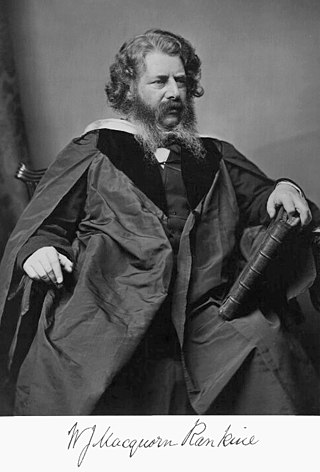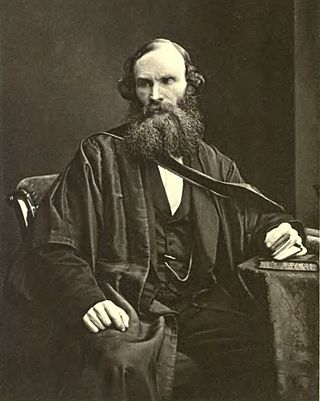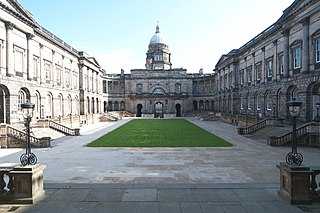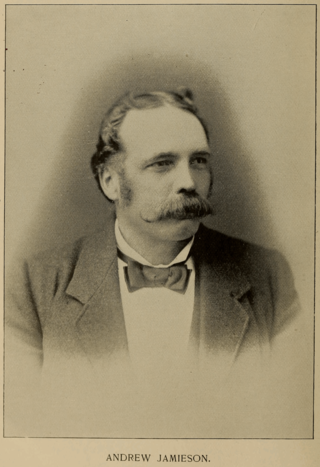
William John Macquorn Rankine was a Scottish mechanical engineer who also contributed to civil engineering, physics and mathematics. He was a founding contributor, with Rudolf Clausius and William Thomson, to the science of thermodynamics, particularly focusing on its First Law. He developed the Rankine scale, an equivalent to the Kelvin scale of temperature, but in degrees Fahrenheit rather than Celsius.
The Regius Chair of Medicine and Therapeutics is considered the oldest chair at the University of Glasgow, Scotland. It was formed in 1989 from the merge of the Regius Chairs of the Practice of Medicine and of Materia Medica. The chair has so far had two occupants, Professor John Reid, who was previously Regius Professor of Materia Medica and - since 2010 - Professor Anna Felicja Dominiczak, the first woman to have ever held the post.

The Regius Chair of Law at the University of Glasgow was founded in December 1713 with an endowment by Queen Anne. It is one of twelve Regius Professorships within the University of Glasgow. The first holder of the chair, William Forbes, was appointed in 1714. The current holder, James Chalmers, was appointed in 2012.
The Regius Chair of Anatomy is a Regius professorship at the University of Glasgow in Scotland.
The Chair of Natural Philosophy is a professorship at the University of Glasgow, in Scotland, which was established in 1727
The Regius Chair of Zoology is a Regius Professorship at the University of Glasgow. It was founded in 1807 by George III of the United Kingdom as the Regius Chair of Natural History. In 1903, when the Chair of Geology was founded at Glasgow University, the title was changed to Zoology.
The John Elder Professor of Naval Architecture and Ocean Engineering at the University of Glasgow, in Scotland, was founded in 1883 and endowed by Isabella Elder (1828-1905) in memory of her husband, John Elder, marine engineer and shipbuilder of Randolph, Elder & Co., (1824-1869).
The Regius Chair of Botany at the University of Glasgow is a Regius Professorship established in 1818.

James Thomson FRS FRSE LLD was a British engineer and physicist, born in Belfast, and older brother of William Thomson.

Allan Glen's School was, for most of its existence, a local authority, selective secondary school for boys in Glasgow, Scotland, charging nominal fees for tuition.
Archibald Barr LLD, FRS FRSE was a Scottish scientific engineer, inventor and businessman. He was a co-founder of Barr & Stroud, and invented the Barr & Stroud Rangefinder.

Sir James McDonald is a British engineer and educator, serving as Principal and vice-chancellor of the University of Strathclyde since 2009. He is the current President of the Royal Academy of Engineering and is also a visiting professor at NYU Tandon School of Engineering.

Sir Thomas Hudson Beare FRSE RSSA was an eminent British engineer. He was successively Professor of Engineering at Heriot-Watt University, Edinburgh, at University College, London, and finally Regius Professor of Engineering in Edinburgh University.

The Regius Chair of Engineering is a royal professorship in engineering, established since 1868 in the University of Edinburgh, Scotland. The chair is attached to the University's College of Science and Engineering, based in the King's Buildings in Edinburgh. Appointment to the Regius Chair is by Royal Warrant from the British monarch, on the recommendation of Scotland's First Minister.
Ronald Nathan Arnold PhD (Sheffield) MS (Illinois) DSc DEng MIMechE MICivilE was a distinguished British engineer.
Alexander Cleghorn FRSE MICE IESS (1859–1922) was a Scottish engineer and shipbuilder. He served as President of the Institution of Engineers and Shipbuilders in Scotland 1919–1921.

Prof Andrew Jamieson CE FRSE (1849–1912) was a Scottish engineer and academic author.
Prof Adam Simpson Turnbull Thomson FRSE FIMechE FICE LLD was a 20th-century engineer and university administrator, serving as the first Vice Principal of Strathclyde University. As an engineer he was involved in rocket research.
Sir William Wallace CBE FRSE LLD was a 20th-century Scottish marine engineer and influential businessman. He was Chairman of Brown Brothers for over 40 years, mainly involved in the technology behind ship construction rather than their design per sae. He was involved with ship design and technological advancement during both world wars, but his ideas were not always successful: including the ill-fated K-class submarines.







